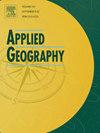基于OTC数据的高速公路客货流空间格局差异——以广东省为例
IF 4
2区 地球科学
Q1 GEOGRAPHY
引用次数: 0
摘要
高速公路城际客货运输反映了不同的社会经济模式。了解这些差异对于城市网络理论和区域发展至关重要,但在过去的研究中,数据的限制阻碍了车辆类型的区分。以广东省为例,利用高速公路在线收费数据构建客货流网络,通过网络分析和随机森林算法检验差异。调查结果总结如下。客货流基本上遵循帕累托分布。客流网络表现出比货运网络更高的密度和凝聚力。对数正态函数最适合描述客流的距离衰减模式,而幂函数最适合描述货流的距离衰减模式。客流范围集中在0 ~ 40公里,而货流范围则集中在0 ~ 100公里。从空间上看,客流具有显著的空间集聚效应,客流主要集中在珠江口两岸。此外,人口因素对客流的影响更为显著,而劳动力和企业因素对货流的影响更为显著。该研究加深了我们对高速公路交通的认识,为车辆分类控制和协同交通治理提供了支持。本文章由计算机程序翻译,如有差异,请以英文原文为准。
Differences in spatial pattern of expressway passenger and freight flows based on OTC data: A case study of Guangdong, China
Intercity passenger and freight transport on expressways reflect distinct socio-economic patterns. Understanding these differences is vital for urban network theory and regional development, but data limitations hinder vehicle type differentiation in past studies. Using Guangdong Province as a case study, we utilized expressway online toll collection data to create networks of passenger and freight flows, examining differences through network analysis and the Random Forest algorithm.The findings are summarized below. Passenger and freight flows largely adhere to a Pareto distribution. Passenger flow networks exhibit higher density and cohesion than freight networks. The lognormal function is the most suitable model for depicting the distance decay pattern of passenger flows, whereas the power function offers the best fit for freight flows. The range of passenger flows is concentrated within 0∼40 km, whereas the range for freight flows is 0∼100 km. From a spatial perspective, a notable spatial agglomeration effect is observed in passenger flows, which primarily concentrate along both sides of the Pearl River Estuary. Additionally, population factors exert a more substantial influence on passenger flows, whereas labor force and enterprise factors significantly impact freight flows. This study deepens our understanding of expressway transport and supports vehicle classification control and collaborative traffic governance.
求助全文
通过发布文献求助,成功后即可免费获取论文全文。
去求助
来源期刊

Applied Geography
GEOGRAPHY-
CiteScore
8.00
自引率
2.00%
发文量
134
期刊介绍:
Applied Geography is a journal devoted to the publication of research which utilizes geographic approaches (human, physical, nature-society and GIScience) to resolve human problems that have a spatial dimension. These problems may be related to the assessment, management and allocation of the world physical and/or human resources. The underlying rationale of the journal is that only through a clear understanding of the relevant societal, physical, and coupled natural-humans systems can we resolve such problems. Papers are invited on any theme involving the application of geographical theory and methodology in the resolution of human problems.
 求助内容:
求助内容: 应助结果提醒方式:
应助结果提醒方式:


